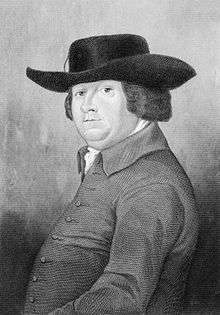Robert Bakewell (agriculturalist)

Robert Bakewell (23 May 1725 – 1 October 1795) was a British agriculturalist, now recognized as one of the most important figures in the British Agricultural Revolution. In addition to work in agronomy, Bakewell is particularly notable as the first to implement systematic selective breeding of livestock. His advancements not only led to specific improvements in sheep, cattle and horses, but contributed to general knowledge of artificial selection.[1]
Early life
Robert Bakewell, the fifth son of Robert and Rebecca Bakewell, was born on 23 May 1725 at Dishley Grange, near Loughborough in Leicestershire. As a young man he travelled extensively in Europe and Britain, learning about other farming methods. Others interested in his work included Prince Grigory Potyomkin and François de la Rochefoucauld (1765–1848).
He supported his revolutionary new breeding techniques with grassland irrigation, flooding and fertilizing pasturelands to improve grazing. He taught these practices to many farmers, and in 1783 formed The Dishley Society to promote them and to advance the interests of livestock breeders. His apprentices and contemporaries, especially Thomas Coke, 1st Earl of Leicester, used his methods to continue improvements to British livestock long after his death in October 1795.[1]
Sheep
Arguably the most influential of Bakewell's breeding programs was with sheep. Using native stock, he was able to quickly select for large, yet fine-boned sheep, with long, lustrous wool. The Lincoln Longwool was improved by Bakewell, and in turn the Lincoln was used to develop the subsequent breed, named the New (or Dishley) Leicester. It was hornless and had a square, meaty body with straight top lines.[2]
These sheep were exported widely, including to Australia and North America, and have contributed to numerous modern breeds, despite the fact that they fell quickly out of favor as market preferences in meat and textiles changed. Bloodlines of these original New Leicesters survive today as the English Leicester (or Leicester Longwool), which is primarily kept for wool production.
Cattle
Robert Bakewell was the first to breed cattle to be used primarily for beef. He crossed long-horned heifers and a Westmoreland bull to eventually create the Dishley Longhorn. As more and more farmers followed his lead, farm animals increased dramatically in size and quality. In 1700, the average weight of a bull sold for slaughter was 370 pounds (168 kg). By 1786, that weight had more than doubled to 840 pounds (381 kg). However, after his death, the Dishley Longhorn was replaced with short-horn versions.
Horses
Robert Bakewell bred the Improved Black Cart horse, which later became a Shire horse.
Influence on Darwin
Selective breeding, which Charles Darwin described as artificial selection, was an inspiration for his theory of natural selection. In On the Origin of Species he cited Bakewell's work as demonstrating variation under domestication, in which methodical breeding during Bakewell's lifetime led to considerable modification of the forms and qualities of his cattle, and the unconscious production of two distinct strains when two flocks of Leicester sheep were kept by Mr. Buckley and Mr. Burgess, "purely bred from the original stock of Mr. Bakewell for upwards of fifty years" with the unanticipated result that "the difference between the sheep possessed by these two gentlemen is so great that they have the appearance of being quite different varieties."[3]
New Dishley Society
The New Dishley Society has been created to promote the memory of Robert Bakewell and of his contemporaries and students of his methods.[4] The society aims to disseminate knowledge of his work and appreciation of his pioneering legacy in the breeding of improved farm livestock and better crop management. It supports research into the revolutionary agricultural techniques of the eighteenth and early nineteenth centuries and into the men who developed these techniques.
See also
Notes
- 1 2 Chisholm 1911.
- ↑ "Robert Bakewell (1725 - 1795)". BBC History. Retrieved 20 July 2012.
- ↑ Beer & Darwin 1996, pp. 397–8
Darwin 1860, pp. 34–36 - ↑ The New Dishley Society. Retrieved 13 June 2009
References
 Chisholm, Hugh, ed. (1911). "Bakewell, Robert (agriculturist)". Encyclopædia Britannica (11th ed.). Cambridge University Press.
Chisholm, Hugh, ed. (1911). "Bakewell, Robert (agriculturist)". Encyclopædia Britannica (11th ed.). Cambridge University Press.- "Robert Bakewell (1725 - 1795)". bbc.co.uk/history. BBC.
- Journal of the Royal Agricultural Society of England. Royal Agricultural Society of England. 1894.
- de la Rochefoucauld, François (1933). A Frenchman in England 1784, ed Jean Marchand. CUP.
- Ekarius, Carol (2008). Storey's Illustrated Breed Guide to Sheep, Goats, Cattle and Pigs. Storey Publishing. ISBN 978-1-60342-036-5.
- Roger J Wood and Vítezslav Orel (2001). Genetic Prehistory in Selective Breeding A Prelude to Mendel. OUP. ISBN 978-0-19-850584-6.
- Roger J Wood (1973). "Robert Bakewell Pioneer Animal Breeder and his influence on Charles Darwin". Casopis Moravskeho (Musea Acta Musei Moraviae).